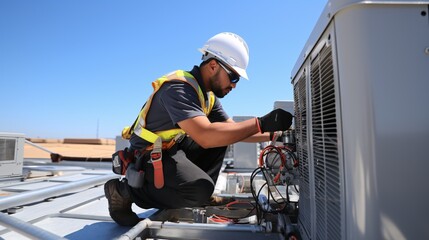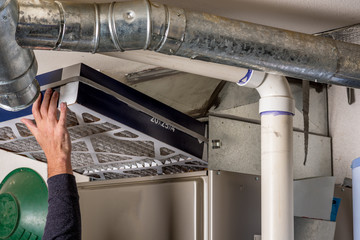How to Get the Most Out of Your Walk-In Cooler
When purchasing a walk-in cooler, there are almost infinite opportunities to customize the unit to your business’s needs. The size, floor insulation, load-bearing potential, and metal finishes are all up to you.
All Temp Air Conditioning & Refrigeration constructs walk-in freezers using insulated panels with poured-in-place polyurethane foam that’s ideal for energy efficiency. This insulation style is fire-resistant, too.
 Door Seals
Door Seals
A door seal is an integral part of any walk-in cooler. They help to keep the cold in and the outside air out, preventing energy waste and reducing food spoilage. Door seals are easy to overlook, but they can wear out and cause major problems if not replaced or maintained. To make sure your walk-in cooler has a good working door seal, perform routine inspections and check that the gasket is tight. You can test this by putting a dollar bill or piece of paper between the door and the frame; if the money easily slides out, then the seal is not tight.
In addition to the door seals, it is also a good idea to replace the insulation in your walk-in cooler every once in a while. This helps to save energy costs, as well as protect your inventory from mold and mildew. You can choose from several different types of insulation, including extruded foam, which is a rigid insulation that guards your walk-in from extreme weather conditions and regulates moisture levels.
Another way to improve the functionality of your walk-in is to install shelving units inside it. These will help you save space and allow for more organized storage of your inventory. Shelving also keeps products off the floor, making it easier to move around and access them. In addition, installing non-slip tape on the floors will prevent staff members from falling and hurting themselves when stocking or retrieving items.
If you are not able to install a shelving unit, then adding strip curtains can be a great option. These curtains hang just in front of the door, and they block cold air from escaping the walk-in while preventing outer air from entering, keeping the temperature in, and preventing pests from getting in.
To make sure that your walk-in is as level as possible, use a carpenter’s level and measure the corner-to-corner distance of each doorframe assembly. If the measurements are not the same, you will need to insert shims under the cabinet supports to raise them into position. This will ensure that the doors will close and lock properly, protecting your inventory.
Strip Curtains
If you work in a restaurant, a grocery store, or any other business that utilizes walk-in coolers, chances are you’ve seen PVC strip curtains in action before. They’re used in walk-in freezers and refrigerators, but they also serve a host of other purposes that make them great for any business with large storage areas.
The overlapping strips of plastic are meant to seal off the walk-in area without blocking it from easy passage for employees. They’re usually transparent, allowing workers to easily move back and forth, even while carrying food, drink, or other supplies. They’re also able to prevent cold air from escaping into non-frozen areas when the doors are open.
Another benefit of strip curtains is that they’re able to stop pests, pollution, dust, and other contaminants from entering the refrigeration space. This is particularly beneficial if you’re working with chemicals or other potentially harmful substances in research labs. The insulating properties of the overlapping plastic strips keep these unwanted contaminants from entering, and they can help protect your staff.
Finally, strip curtains can work to reduce noise levels, making them an excellent choice for workplaces that experience a lot of traffic, like warehouses, loading docks, and restaurants. Excessive noise can be distracting, so reducing it helps keep workers focused and productive.
In addition to their temperature control benefits, these PVC strip curtains can help to lower your energy costs. By reducing the infiltration of ambient air into your walk-in cooler, they can decrease the amount of electricity you need to use to cool the space. You’ll see a noticeable reduction in your energy costs over time, as well as increased sustainability for your business. You’ll also have a more comfortable workspace for your employees, which is always a good thing!
Shelving
For food service businesses, greenhouses, and other commercial operations that need large-scale storage space for ingredients, walk-in coolers are the go-to solution. But to get the most out of your commercial walk-in refrigerator, you need high-quality shelving that’s built to last. Look for wire shelves coated in a corrosion-resistant epoxy finish that’s built to stand up to the cold, humid conditions inside walk-in refrigerators and prevent impurities from seeping into the foods stored on them. These durable shelving racks are also designed to withstand heavy loads, ensuring they can safely hold the largest amount of your most frequently used ingredients.
Another important consideration when choosing walk-in shelving for your business is shelf height. Look for options with adjustable heights that allow you to adjust shelf spacing and product placement with the simple press of a button. This makes it easier to restock your beverage racks without having to take the time to empty and reset everything.
In addition, be sure to select a shelving unit that is easy to assemble, especially if you’re installing it in place of an existing refrigeration system or a prefabricated walk-in cooler or freezer. Then you can get up and running quickly with the least disruption to your workflow. Wait for a slow period or until you’re closed to schedule your delivery and read the manuals or watch the installation videos beforehand so you can familiarize yourself with the walk-in cooler before it arrives.
Lastly, make sure you’re using your walk-in refrigerator or freezer correctly by following the first-in, first-out (FIFO) method for your ingredients and beverages. This ensures that your oldest products are used up before newer inventory is brought in, preventing waste and spoilage. You should also label all your shelves and products to avoid confusion about what’s in each container and when it was bought, as well as to keep track of expiration dates.
Depending on your needs, you may want to consider purchasing a walk-in refrigerator with features like peep windows, LED lights, or door accessories to enhance the visual appeal of your kitchen space and improve functionality. Stainless steel skins are available for those who prefer a sleeker, more modern appearance, while galvanized or painted G90 galvanized finishes are more cost-effective options.
Refrigeration System
Getting the right refrigeration system is a critical part of any walk-in cooler or freezer. It determines the internal temperature of the box, the product load, and any external heat loads such as lighting, motors, or people walking into the box. The refrigeration system will also determine how much energy is needed to keep the walk-in cold, so it’s important to consider this when determining what size box you need and what options you want in your walk-in.
There are two main formats to choose from for your walk-in refrigeration: self-contained systems and split systems. A self-contained system has both the evaporator and condenser housed in one unit that sits on top of the walk-in box. This type of system is commonly used on smaller boxes because it offers a simpler installation and is easier to maintain. The evaporator is cooled by refrigerant that circulates through copper piping from the unit cooler inside the walk-in to the evaporator coil and then back again. The cooling process is similar to that of your home air conditioning, but it’s done with higher temperatures and much more pressure because of the high amounts of refrigerant flowing through the pipes.
If you opt for a self-contained system there are several options available depending on the layout and location of your walk-in. The choice will depend on the amount of space you have for your walk-in, what kind of ventilation is available in the building, and if you want to reduce energy consumption by discharging the heat outside the walk-in box.
Standard top mount systems are self-contained units that come with all parts, copper lines, and refrigeration gases completely installed. These are generally best for small walk-ins but can be used on larger ones as well. The downside of these units is that the evaporator coil hangs down which can take up headroom in small boxes. This can be overcome with the use of strip curtains or an air curtain that can be blown directly above the door. Side mount systems offer many of the same benefits as top-mounted units but are bolted onto a wall of the walk-in instead of hanging down.


